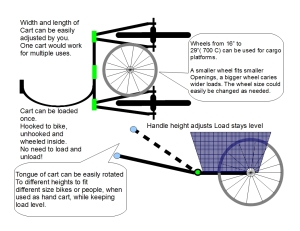Rough prototype as of 1/11/2012
[slideshow]
The cross brace is made from short pieces of bike frame tube matched so the long pieces slide into sleeves, and bolted where needed, with axle bolts and nuts, from scrapped hubs. The tongue which is also part of the cross brace is made from a seat tube and down tube from a step over frame.
There is a seat post binder sleeve and bolt on one side, to allow the tongue to swivel to fit different frame sizes, and to act as a handle when wheeling the cart around on foot, that way the cart acts as a wheel barrow and the load doesn’t have to be transferred when going inside or walking around a farmers market or some other venue that would allow the use of the cart while walking. We’re not sure if the seat bolt binder set up will work yet the tongue may have a tendency to rotate under load, it may have to have a removable pin to lock it in place when it is attached to the bike.
The next step is to make a connector which swivels or rotates both horizontally and vertically, to allow the cart to turn bike and rotate relative to the bike. These can be purchased from trailer manufacturers and through bike shops, but we’re going to try making them out of scraps.


